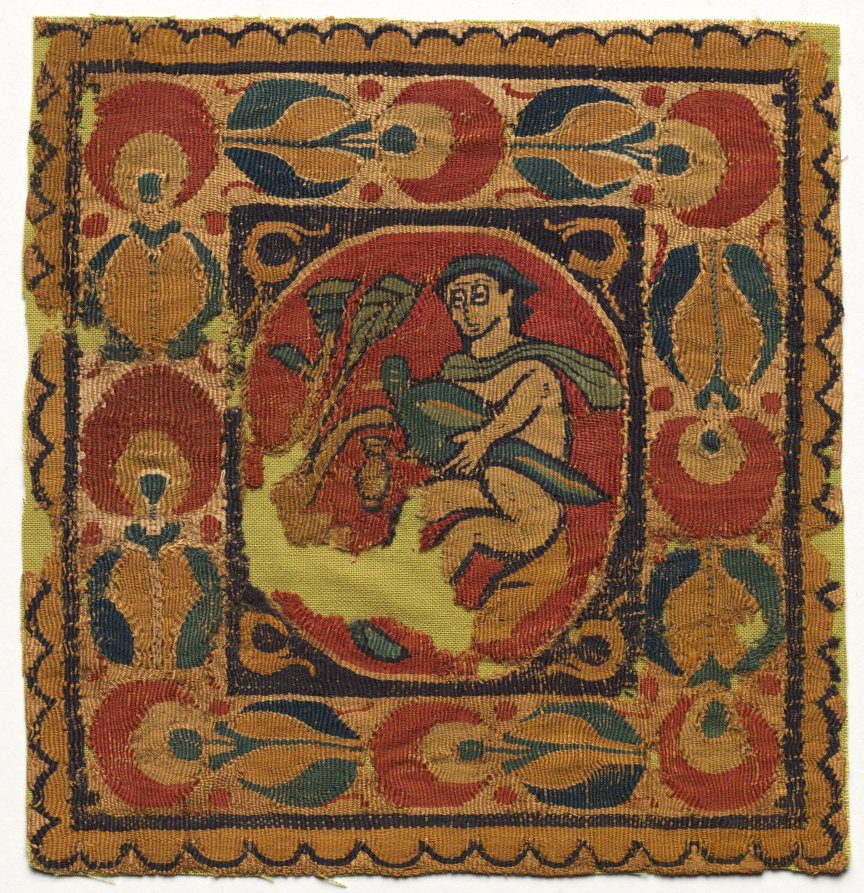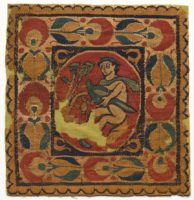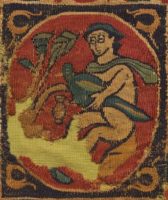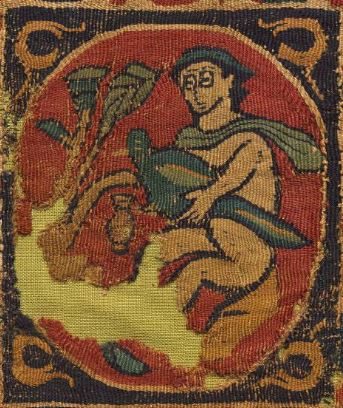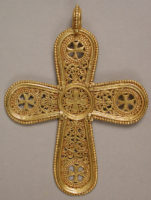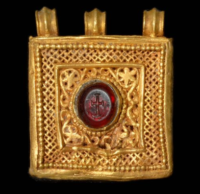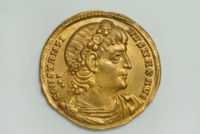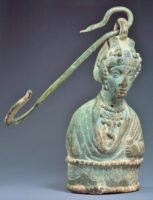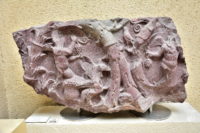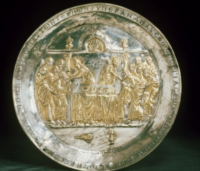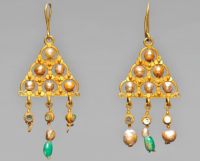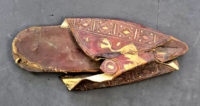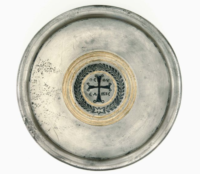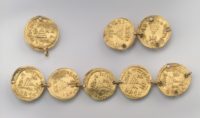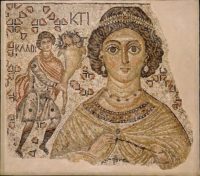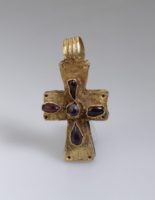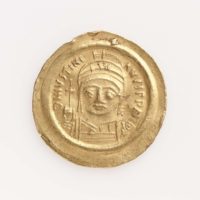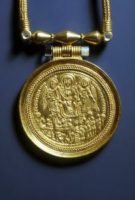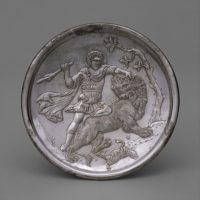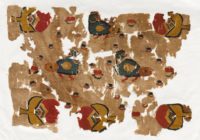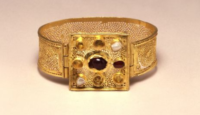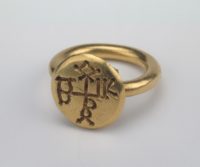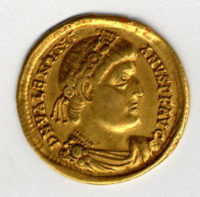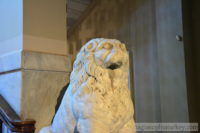Square Segmentum, Period: Early Byzantine; circa: 5th century. Type of art work: Textile, Materials: tapestry; linen and wool. The Cleveland Art Museum Hours: Tuesdays, Thursdays, Saturdays, Sundays 10:00 a.m.–5:00 p.m. Wednesdays, Fridays 10:00 a.m.–9:00 p.m. Closed Mondays.
Gold Cross Pendant, Period: Early Byzantine, circa: 500–700s. Material: Gold. Dimensions: 3 9/16 x 2 11/16 x 1/2in. (9 x 6.8 x 1.2cm). On view at The Met Fifth Avenue in Gallery 301. The Metropolitan Museum of Art (New York) is one of the world’s largest and finest art museums. Its collection includes more than two million works of art spanning five thousand years of world culture, from prehistory to the present and from every part of the globe. Public Hours: 10:30 a.m.–5:30 p.m. Open seven days a week.
Reliquary of St. Zacharias, Period: Early Byzantine, 6th Century, Material: Gold and gems. The museum is open to the public Tuesday through Sunday, 11:30 a.m.–5:30 p.m., except for federal holidays.
Solidus of Constantine I (306–337), Material: Gold. The museum is open to the public Tuesday through Sunday, 11:30 a.m.–5:30 p.m., except for federal holidays.
Steelyard Weight with a Bust of a Byzantine Empress and a Hook. This Byzantine steelyard weight dates from the first half of the 5th century. The bronze hook would permit it to be suspended from and moved along a ruled steelyard to determine the weight of an item hung from the opposite end. The Metropolitan Museum of Art (New York) is one of the world’s largest and finest art museums. Its collection includes more than two million works of art spanning five thousand years of world culture, from prehistory to the present and from every part of the globe. Public Hours: 10:30 a.m.–5:30 p.m. Open seven days a week.
Sarcophagus Fragment of Emperor Constantine the Great (?) Materials: Porphyry Period: Early Byzantine circa: 4th century. In the Istanbul Archaeological Museum collections, there are rich and very important works of art belonging to various civilizations from the regions from Africa to Balkans , from Anatolia and Mesopotamia to Arab Peninsula and Afghanistan that were in the borders of the Ottoman Empire.
Paten with the Communion of the Apostles, Period: Early Byzantine (565-578 A.D.) Materials: silver, gilding and niello. The museum is open to the public Tuesday through Sunday, 11:30 a.m.–5:30 p.m., except for federal holidays.
Earrings (pair), Period: Early Byzantine circa: 600s. Materials: gold. The Cleveland Art Museum Hours: Tuesdays, Thursdays, Saturdays, Sundays 10:00 a.m.–5:00 p.m. Wednesdays, Fridays 10:00 a.m.–9:00 p.m. Closed Mondays.
Slipper; leather; with pointed toe and thick sole with gilt borders on the upper part and the figure of an animal. Culture: Coptic. Period: Early Byzantine; circa: 4thC-6thC; Made in: Egypt. Length: 262 millimetres. British Museum is closed 24, 25 and 26 December and 1 January, but is open every other day of the year. Fast facts about the British Museum: Founded: 1753, Collection size: 8 million objects, Oldest object in the collection: Stone chopping tool (nearly 2 million years old).
Plate with Cross and Greek Inscription ‘Hope of God’, Period: Early Byzantine, 7th century A.D. The museum is open to the public Tuesday through Sunday, 11:30 a.m.–5:30 p.m., except for federal holidays.
Fragment of a Necklace Consisting of Eight Coins, Period: Early Byzantine. circa: Between 637 and 646. Found: Pereshchepina Complex. near Poltava, the Village of Malaya Pereshchepina. Material: gold. The collection of the State Hermitage includes over 3 million works of art and world culture artefacts. It contains paintings, graphic works, sculptures, works of applied art, archaeological artefacts and numismatic objects. The Hermitage is considered to have been founded in 1764, when Empress Catherine the Great acquired an impressive collection of works from the Berlin merchant Johann Ernst Gotzkowsky. The museum celebrates the anniversary of its founding each year on 7 December, St. Catherine’s Day. Opening Hours: Tuesday, Thursday, Saturday, Sunday: 10.30-18.00 Wednesday, Friday: 10.30-21.00 Closed: Monday.
Fragment of a Floor Mosaic with a Personification of Ktisis, Period: Early Byzantine circa: 500–550, with modern restoration. Materials: Marble and glass. The Metropolitan Museum of Art (New York) is one of the world’s largest and finest art museums. Its collection includes more than two million works of art spanning five thousand years of world culture, from prehistory to the present and from every part of the globe. Public Hours: 10:30 a.m.–5:30 p.m. Open seven days a week.
Cross, Period: Early Byzantine, circa: 5th-6th century, Materials: golad and garnet. Dimensions: 3,8×1,9 cm. The collection of the State Hermitage includes over 3 million works of art and world culture artefacts. It contains paintings, graphic works, sculptures, works of applied art, archaeological artefacts and numismatic objects. The Hermitage is considered to have been founded in 1764, when Empress Catherine the Great acquired an impressive collection of works from the Berlin merchant Johann Ernst Gotzkowsky. The museum celebrates the anniversary of its founding each year on 7 December, St. Catherine’s Day. Opening Hours: Tuesday, Thursday, Saturday, Sunday: 10.30-18.00 Wednesday, Friday: 10.30-21.00 Closed: Monday.
Solidus of Justinian I, Period: Early Byzantine, circa: 552–565 A.D. Minted in: Ravenna, Material: Gold. The Museum of Fine Arts, Boston is open 7 days a week. Monday and Tuesday 10 am–5 pm, Wednesday–Friday 10 am–10 pm, Saturday and Sunday 10 am–5 pm.
Enkolpion with Enthroned Virgin, Nativity, Adoration; and Baptism. Period: Early Byzantine Last quarter 6th century (ca. 583). Materials: gold. The museum is open to the public Tuesday through Sunday, 11:30 a.m.–5:30 p.m., except for federal holidays
Plate with David Slaying a Lion, Period: Early Byzantine, circa: 629–630, Materials: Silver, Made in Constantinople, The Metropolitan Museum of Art (New York) is one of the world’s largest and finest art museums. Its collection includes more than two million works of art spanning five thousand years of world culture, from prehistory to the present and from every part of the globe. Public Hours: 10:30 a.m.–5:30 p.m. Open seven days a week.
Fragment of a Curtain, Period: Early Byzantine circa: 500s. Made in: Egypt, Materials: tabby weave, inwoven tapestry ornament; wool and linen, Overall: 38 x 52.3 cm (14 15/16 x 20 9/16 in.). The Cleveland Art Museum Hours: Tuesdays, Thursdays, Saturdays, Sundays 10:00 a.m.–5:00 p.m. Wednesdays, Fridays 10:00 a.m.–9:00 p.m. Closed Mondays.
Bracelet with Jewelled Clasp, Period: Early Byzantine, Date: -circa-Second half 4th Century (possibly 360-80). Materials: gold and gems. The museum is open to the public Tuesday through Sunday, 11:30 a.m.–5:30 p.m., except for federal holidays.
Ring Decorated with a Monogram, Period: Early Byzantine, circa: 7th century. Found: Pereshchepina Complex. near Poltava, the Village of Malaya Pereshchepina. Materials: gold. Technique: cast, polished, soldered and engraved. The collection of the State Hermitage includes over 3 million works of art and world culture artefacts. It contains paintings, graphic works, sculptures, works of applied art, archaeological artefacts and numismatic objects. The Hermitage is considered to have been founded in 1764, when Empress Catherine the Great acquired an impressive collection of works from the Berlin merchant Johann Ernst Gotzkowsky. The museum celebrates the anniversary of its founding each year on 7 December, St. Catherine’s Day. Opening Hours: Tuesday, Thursday, Saturday, Sunday: 10.30-18.00 Wednesday, Friday: 10.30-21.00 Closed: Monday.
Gold Solidus of Valentinian I (364–75), Made in Nicomedia (Modern Izmit, Turkey), Material: Gold. Valentinian restored Christian symbols, including the Chi-Rho emblem atop the emperor’s standard. On view at The Met Fifth Avenue in Gallery 301. The Metropolitan Museum of Art (New York) is one of the world’s largest and finest art museums. Its collection includes more than two million works of art spanning five thousand years of world culture, from prehistory to the present and from every part of the globe. Public Hours: 10:30 a.m.–5:30 p.m. Open seven days a week.
Lion Statue from the monumental gate of Bucaleon Palace. Period: Early Byzantine, Findspot: Catladikapi, Istanbul, Material: Marble.
In the Istanbul Archaeological Museum collections, there are rich and very important works of art belonging to various civilizations from the regions from Africa to Balkans , from Anatolia and Mesopotamia to Arab Peninsula and Afghanistan that were in the borders of the Ottoman Empire.


